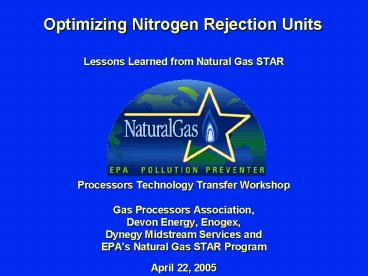Optimizing Nitrogen Rejection Units - PowerPoint PPT Presentation
1 / 16
Title:
Optimizing Nitrogen Rejection Units
Description:
Dynegy Midstream Services and. EPA's Natural Gas STAR Program. April 22, 2005. Page 2 ... Gas with high nitrogen must be processed to meet heat content specifications ... – PowerPoint PPT presentation
Number of Views:247
Avg rating:3.0/5.0
Title: Optimizing Nitrogen Rejection Units
1
Optimizing Nitrogen Rejection Units
- Lessons Learned from Natural Gas STAR
- Processors Technology Transfer Workshop
2
Agenda
- Nitrogen Contamination in Natural Gas
- Methane Losses from Nitrogen Rejection
- Methane Recovery
- Partner Experience
- Is Recovery Profitable?
- Discussion Questions
3
Nitrogen Contamination in Natural Gas
- 16 of US gas reserves contain large volumes of
nitrogen - Gas with high nitrogen must be processed to meet
heat content specifications (about 4 nitrogen by
volume) - Wellhead gas can have well over 15 nitrogen,
especially in associated gas production - Nitrogen is sometimes injected for enhanced oil
recovery operations and for pressure maintenance - Unacceptable levels of nitrogen can be removed
with a Nitrogen Rejection Unit (NRU)
www.engelhard.com
4
Processing Sector Emissions
- Methane losses from NRUs are included in blowdown
venting and plant fugitives
Plant Fugitives 2 Bcf
Dehydrators and Pumps 1 Bcf
Blowdowns 2 Bcf
Other Sources 1 Bcf
Centrifugal Compressors 6 Bcf
Reciprocating Compressors 17 Bcf
Gas Engine Exhaust 7 Bcf
5
Methane Losses from Nitrogen Rejection
- NRU fugitives
- Methane leaks occur at valves, piping connectors
and open ended lines - Natural Gas STAR accounts for these leaks in
processing plant fugitive emissions - Nitrogen reject vent
- Reject stream usually contains some methane, 1 to
5 - Natural Gas STAR accounts for these vents in
processing plant blowdown/venting emissions
6
NRU Fugitives
- Clearstone study of 4 processing plants measured
NRU fugitives
Emission Factor (Mcf/yr/component) Activity Factor (components/plant) Emissions (Mcf/yr)
NRU Valves 11.37 101 1,148.70
NRU Connectors 2.50 242 604.04
NRU PRVs 0.00 2 0.00
NRU Comp Seals 0.00 1 0.00
NRU OELs 7.77 8 62.15
Total NRU Fugitive Emissions Total NRU Fugitive Emissions Total NRU Fugitive Emissions 1,815
Total Gas Plant Fugitive Emissions Total Gas Plant Fugitive Emissions Total Gas Plant Fugitive Emissions 41,116
7
NRU Vented Methane
- Methane is lost in the nitrogen reject stream
- On-line gas chromatograph can alert operators to
the methane content of the reject stream - Over a year, the small fraction of methane in the
reject stream can add up to significant methane
loss - NRU optimization can reduce product loss in the
reject stream, with a payback of lt1 year
8
Nitrogen Rejection Unit
- Large gas feeds with nitrogen content of 10 or
greater are best processed with cryogenic NRUs - All sulfur, water, and mercury must be removed
first to avoid
corrosion - Dry gas then cooled to cryogenic temperatures
wheremethane condenses - Non-condensable gasespurged and vented to the
atmosphere
9
NRU Setup
Cold Box 1
Nitrogen Rejection Columns
Methane Preseparation Column
Feed Gas
Nitrogen Reject
gt10 N2
98.5 N2
Plate-fin Heat Exchangers
Cold Box 2
Centrifugal Gas Compressor
To Pipeline
Methane Pumps
lt5 N2
NRU Bypass
10
Methane Recovery Optimizing NRU
- Building a process-specific model of your NRU is
crucial to optimization - Model all equipment in the process
- Include all input material and energy streams and
typical variations for those streams - Sensitivity calculations can help to develop
recommendations for maintenance and process
modification - Prioritize recommendations and develop a
maintenance schedule
11
Optimization Activities
- Depends on the process model results
- Adjust temperature/pressure in nitrogen reject
columns - Inspect and clean heat exchangers
- Re-tray nitrogen reject columns
- Prioritize activities
- Temperature/pressure adjustments can be made by
control systems - Replacing column trays requires unit to be taken
out of service
12
Partner Experience
- One Gas STAR partner operating an older NRU took
steps to optimize their process - NRU was 20 years old
- High nitrogen composition gas (60 N2)
- On-line chromatograph showed 5 methane in reject
stream - Contractor hired to develop a process model and
provide process optimization recommendations
13
Optimization Recommendations
- Change control settings
- Adjust nitrogen reject column reflux
- Perform maintenance
- Fix leaking valve that had iced over
- Change process equipment
- Re-tray columns with higher efficiency trays
- Scheduled at a later date
14
Methane Savings
- After performing recommended activities (aside
from replacing column trays) methane in the
reject stream was reduced from 5 to 2 - 50 MMcf/day NRU with 60 inlet nitrogen saved
over 200,000 Mcf/yr - Additional savings are anticipated from replacing
column trays
15
Is Recovery Profitable?
- Gas savings of 200,000 Mcf/yr
- Optimization costs
- 35,000 for process model development on existing
software - 15,000/yr for plant maintenance
16
Discussion Questions
- Is the methane content of the nitrogen reject
stream continuously monitored in your NRU? - How can this presentation be improved to help you
determine your opportunities for NRU methane
savings? - What other activities have you undertaken to
increase the efficiency of your NRU?































